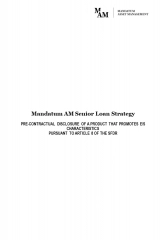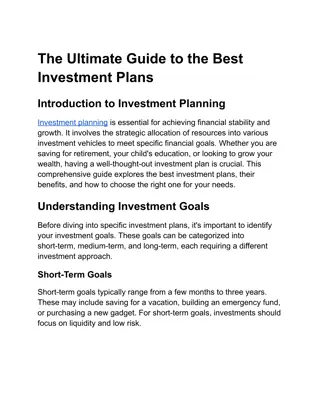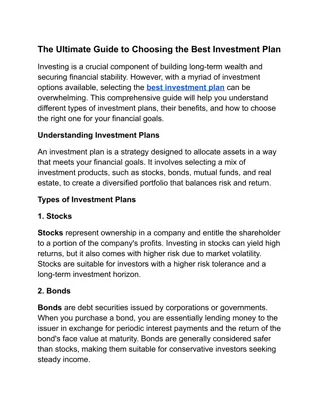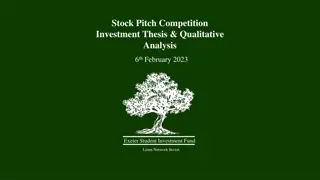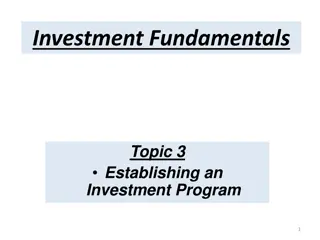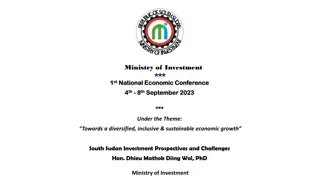Business Case for Investment in New Variety Development
Emphasizing the shift from viewing plant breeding as a cost to recognizing it as an investment that yields returns, this chapter focuses on creating compelling business cases for investments in demand-led plant breeding. It discusses investment decisions, costs estimation, and management, highlighting the economic, social, and environmental benefits of successful plant breeding. The content delves into the importance of understanding benefits and costs to justify investment in new variety development.
Download Presentation

Please find below an Image/Link to download the presentation.
The content on the website is provided AS IS for your information and personal use only. It may not be sold, licensed, or shared on other websites without obtaining consent from the author.If you encounter any issues during the download, it is possible that the publisher has removed the file from their server.
You are allowed to download the files provided on this website for personal or commercial use, subject to the condition that they are used lawfully. All files are the property of their respective owners.
The content on the website is provided AS IS for your information and personal use only. It may not be sold, licensed, or shared on other websites without obtaining consent from the author.
E N D
Presentation Transcript
The Business of Plant Breeding: Market-led approaches to new variety design in Africa Demand-Led Plant Breeding Training Manual Chapter 7 The Business Case for Investment in New Variety Development Rowland Chirwa
Chapter 7 The Business Case for Investment in New Variety Development Rowland Chirwa Chitedze Agricultural Research Station P.O. Box 158, Lilongwe, Malawi
Objectives To strengthen plant breeders ability to create compelling business cases for investments in demand-led plant breeding
Contents 1. Introduction 2. Investment Decisions 3. Cost Estimation and Management 4. Investment Decision Making
1. Introduction Changing perception of breeding as a cost to breeding as an investment that gives a return Plant breeding bring benefits to many people - farmers, consumers and others in value chain Successful plant breeding brings economic, social and environmental benefits
Group Discussion List all potential benefits from a breeding programme? List types of costs for creating a new variety What provides a convincing investment case to R&D managers, public and/or private sector investors?
Benefits and Investment Case Study Analysis of Australian chickpea case study Example for review on how to create a compelling benefits and investments case GRDC Investments in Australian national chickpea breeding programme. Available at: http://www.grdc.com.au/Research-and- Development/Impact-Assessment
Investment Decisions Breeders need to justify a plant breeding programme for specific market demanded varieties - as an investment rather than an expenditure on the institute's budget. Making the case for a new demand-led breeding project requires understanding the benefits and costs and balancing them to justify investment in new variety development versus alternative options.
Benefits and Beneficiaries Examples of benefits and beneficiaries in Table 7.1 below
Quantification units Beneficiary Specific benefit Benefit consequence Benefit type Farmer income, Shift from subsistence farming to entering markets, Business growth, Can afford education for child Greater yield Economic USD Earlier or later cropping (than vs. main season) Improved crop quality Improved plant architecture Farmers Higher prices (as less supply) Economic USD Higher price, more customers Easier harvesting Time saving Farmer income, Unit costs are less More competitive price to distributors Economic USD Economic USD Greater seed yield, Higher productivity per area grown USD/person hours Seed producers Economic Less damage in transit Improved shelf-life Source from local farmers rather than imports Transporters Cost saving Economic USD Wholesalers Food processing companies Cost saving Cost saving Reliable supply Freshness and higher prices Differentiation and fair trade brands Loss of wastage and costs Economic Economic, Logistics USD USD Good varieties and sourcing from local smallholders Food retailers/ Supermarkets Improved shelf-life Economic, Social Economic, Social Easier preparation Time saving USD Consumers Shorter cooking time Energy saving USD Public investors Governments , International dev. agencies) Economic development, Continued funding for plant breeding projects and support for innovation and science Deliver their mandate, Support balance of payments, Economic development, Farmer livelihoods Economic, Social USD
3. Cost Estimation and Management Examples of likely costs in breeding programme in Table 7.2 (as cash or personnel (FTE) costs)
Discipline or item Manpower (FTE) Cash Farmer and value chain market research Meetings and consultations with farmers and the value chain to define needs and priorities to create variety designs and set breeding targets and goals, Specific market research studies Project governance and decision-making Management meetings to review project progress and make stage plan advancement decisions and including clients/stakeholders Project management to create the demand-led development plan, monitor and evaluate progress Investment case creation - discussions with economists, social scientists, management and budget holders to create case comprised of project benefits and costs. Project proposal and plan creation (and liaison with donors if required) YES YES YES YES YES YES YES YES Plant breeding Plant breeders Laboratory or greenhouse technicians Molecular biology: sequencing, genotyping and other data analysis Experimental design and Data management Bioinformatics advice and statistics packages Computer access and power Germplasm evaluation Farm trial operations - labour (on-site, off-site) Farmer participatory breeding trials Agronomists Plant protection Soil scientists Processing performance tests Food company or other value chain stakeholders performance tests Consumer based assays (including out-sourcing) e.g. cooking and taste trials YES YES YES YES NO YES YES YES YES YES YES YES YES YES YES YES YES YES NO YES NO NO NO YES YES YES
Key Messages Understanding the value and costs of investing in plant breeding is critical to success for a breeder Detailed analysis is required on the merits of each case and the strength and degree of certainty of each assumption When the benefits are higher than the costs, it may be worth making the investment in developing a new variety Opportunity cost: Also consider alternative variety design, activity option or other breeding program that could be a better investment choice for using the resources available
Investment Analysis Tool Project rationale Financial metrics as inputs for analysis E.g. seed market size, projected growth, market share of new variety, gross profit on seed; total breeding costs Outputs: Investment analysis Performance and investment metrics Demonstration on how to use Investment Tool (Appendix 7.1)
The Business of Plant Breeding: Market-led approaches to new variety design in Africa Demand-Led Plant Breeding Training Manual Chapter 7 Making the Case for Investments in New Variety Development Rowland Chirwa


